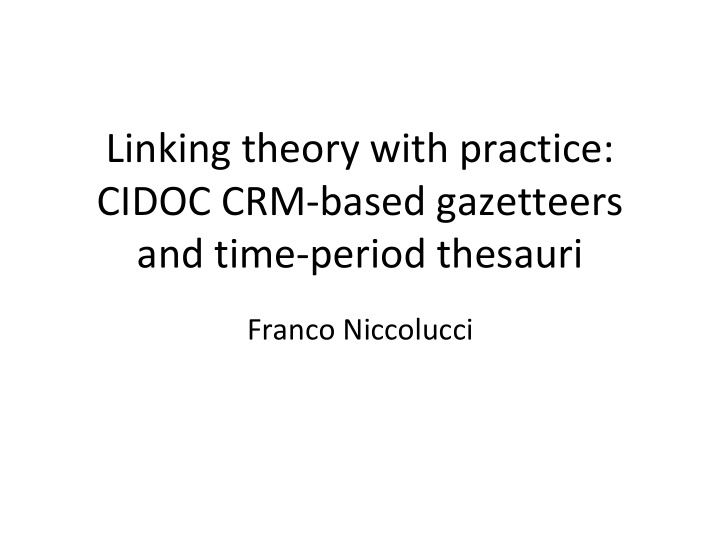



Linking theory with practice: CIDOC CRM-based gazetteers and time-period thesauri Franco Niccolucci
The problem • Archaeologists and historians use (as we all do) names to indicate locations and to indicate periods • Processing such names requires (preferably) to turn these names into intervals or geometric regions • But, associating names to time intervals and/or space extent is tricky : a named period usually corresponds to different time intervals in different locations, and the location of a named place may vary according to time • Additionally, these correspondences vary together: they are functions of the two variables
Further complication for time… • Period names in archaeology are often not just a shortcut to indicate a time interval, but they correspond to cultural concepts • ‘Iron Age’ means ‘when mankind used iron technology’ • ‘The orientalizing period’ in the Etruscan civilization means ‘the period in which Etruscan art style is influenced by Middle- eastern patterns’
…same for space • A named region may correspond to different space extents according to what we mean: • Language • Culture • Politics • Administrative borders • Additionally, when talking about the past, the area may have undetermined or fuzzy borders
The ARENA diagram
The merchant paradox • A merchant travels from Gaul to England in 15 AD across the Channel • This merchant would also travel in time, from the Roman Period to Iron Age • Unless one acknowledges that Iron Age in Gaul has a different time-span than in England, and 15 AD belongs exactly to the period in which Gaul was in the Roman Period and England was still in the Iron Age
How do we manage this? • Ignore. When using geonames or any other modern gazetteer the time span is ‘today’ • Assume that time or space are independent variables in the association of time/space to a name • Pleiades deals with space, and assumes that a place appellation remains constant for some time interval (the ‘attestation’) • PeriodO assumes that named time periods remain stable within certain regions
Pro’s and con’s • In practice these solutions work, some better than others • From a theoretical perspective they do not have robust bases: time and space are a continuum and in the association with the respective appellations they are not independent from each other • It is difficult to deal with a continuum, and actually one never does it
CIDOC CRM • The CRM has acknowledged (but perhaps not solved…) the difficulty of dealing with space and time together • In the CRMgeo extension it developed the concept of space-time volume as the extent of space and time occupied by an event: this needs to be embedded in 4-dimensional space to keep into account that the two variables are not independent from each other • The space-time volume has recently been included in the body of CRM as E92
The CRM space-time volume
An old trick to manage the issue • An old mathematical trick to manage the issues of continuum was invented by Archimedes: the method of exhaustion • As any student knows, it consists in approximating continuously varying quantities by small intervals in which they may be considered as constant • It is assumed that when reducing the size of such intervals, the difference between the variable and the approximation may be reduced ‘as small as you like’
What happens with space and time • The exhaustion method works even better in our case because there are thresholds • For space, archaeology does not go down to atomic size • For time, there is no way of appreciating instantaneous change • There is a ‘natural’ granularity of time and space below which it is meaningless to go
Time and space granules • It may be safely assumed that we may find some minimal hypercube within which there is no (joint) variability of space and time appellations, and it makes no archaeological sense to consider variations below that threshold • For example, one may assume that this is 1 hour and 1 cubic meter • Actually the granularity varies in time and space, but we may think of choosing the smallest one
Slicing the potato
How the trick works • After ‘slicing the potato’ into small cubes one may reassemble the granules where space and/or time appellations remain the same and safely define named periods and geographical names • The degree of refinement depends on the intended use • This is aimed only to give sound foundations to gazetteers and named period lists
A bit of additional confusion What is a place? • For Pleiades, a place is constructed by human experience, i.e. it is the way they perceive and describe places • There is a terminological mismatch: what the CRM calls E53 Place is a ‘Location’ in the Pleiades terminology • For the CRM, the pleiades:place is closer to the concept of space-time volume
Places • Actually Pleiades (and most gazetteers) is based on a conceptual definition of place as contained in sources, so there are three levels: • A place (possibly ancient) described in a source • A place as perceived by humans • A place geographically determined on the Earth or a representation like a geographic system • They should be modeled differently
Conceptual Places • Conceptual places are a mental construct: they may correspond to • Actual places: Poznan • Unknown places: the tomb of Alexander the Great • Dubious places, but quoted in sources: Atlantis; Ararat, the landing place of Noah’s Arch • Imaginary places: Peter Pan’s Neverland island • It is proposed to introduce a new CRM class Conceptual Place
Naming
‘Connections’
What next? • Exploring other Pleiades concepts • Completing the reconciliation of Pleiades and the CRM • Analyzing the named time period foundations • Analyzing the archaeological implications, and how archaeological theory affects all of the above
Recommend
More recommend